
Canoe slalom is a competitive sport with the aim to navigate a decked canoe or kayak through a course of hanging downstream or upstream gates on river rapids in the fastest time possible. It is one of two kayak and canoeing disciplines at the Summer Olympics, and is referred to by the International Olympic Committee (IOC) as Canoe/Kayak Slalom. The other Olympic canoeing discipline is canoe sprint. Wildwater canoeing is a non-Olympic paddlesport.
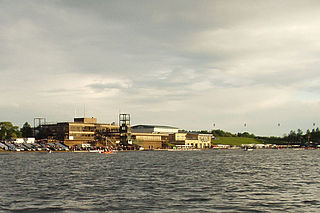
Holme Pierrepont Country Park, home of The National Water Sports Centre is located in the hamlet of Holme Pierrepont near Nottingham, England and on the River Trent. It is used for many differen sports and has received investment which has enabled a major refurbishment of existing facilities as well as introduction of new facilities.
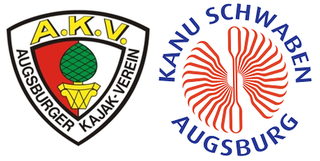
The Augsburg Eiskanal is an artificial whitewater river in Augsburg, Germany, constructed as the canoe slalom venue for the 1972 Summer Olympics in nearby Munich.

The Penrith Whitewater Stadium is located near Sydney, Australia. It is an artificial whitewater sporting facility which hosted the canoe/kayak slalom events at the 2000 Summer Olympics in Sydney. The facility is part of the Penrith Lakes Scheme, which is converting open-pit sand and gravel mines into lakes for recreation. It is close to Cranebrook and is adjacent to the Sydney International Regatta Centre. These lakes are not filled via the Nepean River, but are filled via rain water and ground water. The operation of the facility aerates the water and improves water quality in the flat water rowing and canoeing course.

The U.S. National Whitewater Center (USNWC) is a not-for-profit outdoor recreation and athletic training facility for whitewater rafting, kayaking, canoeing, rock climbing, mountain biking, hiking and ice skating which opened to the public in 2006. The Center is located in Charlotte, North Carolina on approximately 1,300 acres (530 ha) of land adjacent to the Catawba River, with more than 50 miles (80 km) of developed trail.

The Tees Barrage International White Water Course, originally the Teesside White Water Course, is an artificial whitewater course on the north bank of the River Tees, in northern England. It is part of the Tees Barrage and is located in the Stockton-on-Tees district, accessible by road only from Thornaby-on-Tees and best accessed by the A66. The course was built in 1995 at a cost of £2 million. The course is now open once more under the new name TBIWWC.

The Nene Whitewater Centre is a whitewater centre which was the UK's first pumped artificial whitewater course. It is located on the River Nene in Northampton.

Cardington Artificial Slalom Course (CASC) was the first artificial whitewater canoe slalom course in the UK when it was completed in July 1982, having been first discussed in 1972.

The Dickerson Whitewater Course, on the Potomac River near Dickerson, Maryland, was built for use by canoe and kayak paddlers training for the 1992 Olympic Games in Spain. It was the first pump-powered artificial whitewater course built in North America, and is still the only one anywhere with heated water. It remains an active training center for whitewater slalom racing, swiftwater rescue training, and other whitewater activities.

Parc Olímpic del Segre is a canoeing and kayaking facility in La Seu d'Urgell, Catalonia, Spain, built in 1990 for use during the 1992 Summer Olympics in Barcelona.
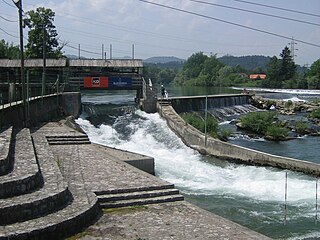
The Tacen Whitewater Course is a venue for canoe and kayak slalom competition in Tacen, Slovenia, a suburb of Ljubljana. Located on the Sava River, eight kilometers northwest of the city center, it is known locally as Kayak Canoe Club Tacen. The course played an important role in development of the sport during the past six decades. In 1939, when its first competition was held, it was a natural rapid at the base of a dam in the Sava River. In 1990, after many upgrades, it was given a concrete channel and the features of a modern Olympic-style slalom course. The course now starts in the lake behind the dam, and the spillway is the first drop. Tacen hosts a major international competition almost every year, examples being the 1955, the 1991, and the 2010 Championships.

The Ocoee Whitewater Center, near Ducktown, Tennessee, United States, was the canoe slalom venue for the 1996 Summer Olympics in Atlanta, and is the only in-river course to be used for Olympic slalom competition. A 1,640 foot stretch of the Upper Ocoee River was narrowed by two-thirds to create the drops and eddies needed for a slalom course. Today, the course is watered only on summer weekends, 34 days a year, for use by guided rafts and private boaters. When the river has water, 24 commercial rafting companies take more than 750 raft passengers through the course each day.

The Čunovo Water Sports Centre is an artificial whitewater slalom course in Slovakia, on an island in the Danube river, 14 km southeast of Bratislava, near the village of Čunovo. It is powered by flow diversion from the Čunovo dam. Since 1997, it has hosted a full schedule of local, regional, and international competitions, including multiple World Cup races, 2 European Championships and the 2011 World Championships.

Kanupark Markkleeberg, built in 2006, is the second of two artificial whitewater canoe/kayak slalom courses in Germany, and the only one powered by pumps. The other German course is the Eiskanal in Augsburg, used in the 1972 Summer Olympic Games in Munich. Kanupark Markkleeberg is located on the southeast shore of Markkleeberger See, a lake south of Markkleeberg, a suburb on the south side of Leipzig. A former open-pit coal mine, the lake was flooded in 1999 with groundwater and developed as a water recreation area. The lake is part of the Leipziger Neuseenland, the largest landscape construction project in Europe, which is reclaiming formerly barren industrial and mining sites for recreational use.
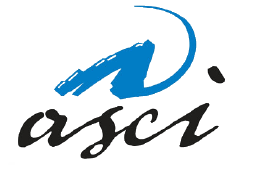
Adventure Sports Center International is an Olympic standard white water rafting and canoe/kayak slalom center located on the mountaintop above the Wisp Ski Resort at Deep Creek Lake, McHenry, Maryland, United States. In addition to serving as a venue for slalom races and training, the center offers a range of services to the general public including guided raft trips, inflatable kayak rentals, and riverboard rentals.

Canoeing – recreational boating activity or paddle sport in which you kneel or sit facing forward in an open or closed-decked canoe, and propel yourself with a single-bladed paddle, under your own power.

Pau-Pyrénées Whitewater Stadium is the home training facility for the French national canoe slalom team. It was first used to train the French team for the 2008 Summer Olympics in Beijing. It 2009, it was the first of three venues used in the canoe slalom World Cup. It is also a whitewater park for recreational use by the general public.

The Ondrej Cibak Whitewater Slalom Course, in Liptovský Mikuláš, Slovakia, is the world's second-oldest artificial whitewater venue for international canoe slalom competition, after the Augsburg Eiskanal. Built in 1978, it diverts water around a small dam on the Váh river. With recent upgrades, including a covered stadium for spectators, it remains a prime site for the sport.
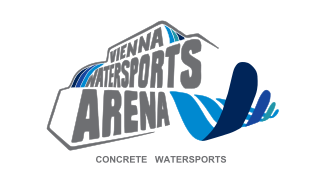
The Vienna Watersports Arena is an artificial whitewater venue for canoe and kayak slalom competition in Vienna, Austria, the only such facility in Austria. It also serves as a family water park, with guided raft trips and practice times for individual boaters. Located across the Danube from the city, on Danube Island, it pumps its water from the New Danube river channel. It opened in August 2013; the following June it hosted the 2014 European Canoe Slalom Championships.























